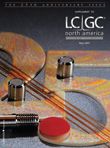Corporate Retrospective 2007: Gerstel
As a family business, GERSTEL has always enjoyed freedom from short-or medium-term interests of investors, allowing us to pursue promising long-term strategies and projects.
As a family business, GERSTEL has always enjoyed freedom from short-or medium-term interests of investors, allowing us to pursue promising long-term strategies and projects. The GERSTEL tradition is to supply a steady stream of innovative solutions for chromatography sample handling and sample introduction, providing increased performance and improved system ruggedness. In 2006, GERSTEL was the leading Channel Partner of Agilent Technologies worldwide, an important milestone. The company was founded in a garage 40 years ago and has been established in the US since 1994.

Among the earliest products from GERSTEL were preparative fraction collectors for LC used by pharmaceutical companies for compound purification. By the mid-seventies, when almost all GC instruments were designed for packed columns, GERSTEL became known for connection technology. GC instruments were adapted to the emerging capillary glass column technology. The technology later provided leak-free connections for fused silica capillary columns.
In 1985, inlet technology was introduced to help provide discrimination-free GC sample introduction and analyte concentration, paving the way for a series of solvent-free extraction and analyte concentration solutions. After some years in LC sample preparation, GERSTEL added LC–MS solutions, including automated solid phase extraction (SPE), to the portfolio in 2006. Our integrated software helps control every step of the process, from automated sample prep through sample introduction to control of the entire LC–MS or GC–MS system.
At GERSTEL, we are thrilled to see continuing growth from pursuing our strategy of making labs more productive by automating sample preparation, improving detection limits and helping to remove solvent from the lab environment in the process.
We are extremely satisfied to be working with LCGC North America, helping us to learn about new trends and new techniques while presenting our news to the world. We wish LCGC continued success going forward and we look forward to working with you on this exciting journey.

Ralf Bremer, Holger Gerstel, and Eberhard Gerstel
Ralf Bremer, Holger Gerstel,
and Eberhard Gerstel
GERSTEL GmbH & Co.KG
Germany

Determining Neurotransmitters in Spinal Cords with UHPLC
February 18th 2025Researchers at Jilin University (Changchun, China) developed a highly sensitive, rapid, and accurate method for analyzing neurotransmitters (NTs) in rat spinal cord tissue. Ultra-high performance liquid chromatography-triple quadrupole tandem mass spectrometry (UHPLC-QqQ-MS/MS) in conjunction with ultra-ionic liquid dispersive liquid-liquid microextraction (UA-MIL-DLLME) were used to extract NTs for analysis.
The Next Frontier for Mass Spectrometry: Maximizing Ion Utilization
January 20th 2025In this podcast, Daniel DeBord, CTO of MOBILion Systems, describes a new high resolution mass spectrometry approach that promises to increase speed and sensitivity in omics applications. MOBILion recently introduced the PAMAF mode of operation, which stands for parallel accumulation with mobility aligned fragmentation. It substantially increases the fraction of ions used for mass spectrometry analysis by replacing the functionality of the quadrupole with high resolution ion mobility. Listen to learn more about this exciting new development.
Revolutionizing LC-MS with Next-Gen Separation for Cyclic Peptide Analysis
February 17th 2025Cyclic peptides, known for their stability and high specificity, are promising therapeutic agents in the fight against cancer, infections, and autoimmune diseases. However, developing effective cyclic peptides presents numerous challenges, including poor pharmacokinetics, efficacy, and toxicity. Traditional methods like liquid chromatography tandem-mass spectrometry (LC-MS/MS) often struggle with resolving isomeric linear peptide metabolites, posing significant risks in safety, efficacy, and regulatory approval. In this paper, Komal Kedia, PhD, will share how she leveraged MOBIE’s high-resolution ion mobility-mass spectrometry (IM-MS) system to achieve a 72% reduction in run times, 200% greater resolving power, and enhanced accuracy in identifying “soft spots” prone to enzymatic degradation.
























